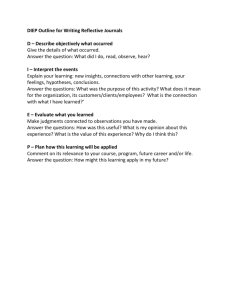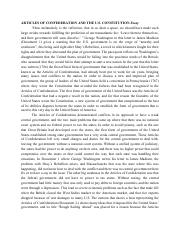
Learn more about the different types & examples of reflective writing including journal, learning diary, peer review and more When you write a reflective paper example, you write about your own experiences and explore how you’ve changed, grown or developed because of those experiences. There’s no standard format for this essay as it may vary depending on the target audience Remember that you are not just writing to say something but to share an important lesson in life. 1. Think of an important event. What you will be writing on your reflective essay is something that is rooted in your own personal experience or encounter of something. Think deep and concentrate
How to use DIEP | Learning Lab
Use the DIEP process to guide your reflective writing and help you stay focused and on task. An insight is something new that you learned or realised. The insight must be relevant to the course and ideally could change your thinking or behaviour in the future. Your insight may apply to your studies, your professional practice, or your future goals. Provide brief and relevant details example of diep reflective writing the situation from which you gained the insight.
Say what was happening when this learning occurred, example of diep reflective writing. After describing your insight and the circumstances, you need to discuss its meaning. Interpret what the insight means.
You can:. Once you have considered the meaning of the insight, you can discuss its value. What relevance does it have? How does it benefit your:. Plan and transfer new learning. Log in to leave feedback. Copyright © RMIT University - Disclaimer Privacy ABN 49 CRICOS provider number: A Open Universities Australia. RMIT Australia. New to university? Managing my time Studying efficiently Starting my first assignment. Overall Researching your assignment Beginning Essays Methodology Reports Case studies Conclusion Literature review - Overview Example Reflective writing Oral presentations Annotated bibliographies Artist statement Group work Law resources.
Academic integrity Paraphrasing Linking words Paragraphs Sentence construction Spelling Academic style Referencing Example of diep reflective writing for the workplace Argument analysis. Mind mapping Note-taking Reading skills Exam preparation Critical thinking.
Algebra Arithmetic Complex numbers Differential equations Differentiation Equation solving Functions and graphs Indices, logs, surds Integration Laplace transforms Matrices Numerical methods Statistics Trigonometry Vectors. Chemistry Nursing calculations Physics. Tips from students Academic word list tool Useful websites English practice activities login required.
Writing for coursework Literature review Critical reading Resources for research students. RMIT Australia RMIT Europe RMIT Vietnam RMIT Global RMIT Online. Close search. Learning Lab. Search Learning Lab Search, example of diep reflective writing. How to use DIEP. Describe the insight An insight is something new that you learned or realised. Examples The most important thing I realised this week is the role of questioning in project management A reading technique that I have learned recently that I find most valuable for my study is pre-reading, especially skimming and scanning 2.
Describe the circumstances Provide brief and relevant details of the situation from which you gained the insight. What was the context? on placement, example of diep reflective writing, during reading What was the particular trigger?
a comment from a patient, a concept in the readings, a particular question or activity in class Examples I learned this from the lecture in Project Example of diep reflective writing Techniques by a guest lecturer, Dr Strangelove.
She started her presentation by asking us to build a tower from straws I learned about these techniques for efficient reading from an exercise using a chapter from Anstey about the four resources model. We used the skimming technique which involves noting full details about the text and what it contains before reading it. We had to look at the whole chapter to identify the main ideas through the headings. I realised I can get a lot of information about the main ideas in a text without actually reading it, example of diep reflective writing.
You can: explain why the insight is significant in general but particularly to you discuss the questions it raises in general or for you make connections between the insight and the course, theory or literature Now go deeper to analyse your insight by exploring such aspects as: What the insight might mean in general and for you.
What factors influenced, formed or informed your insight e. previous events or learning your personality type the setting or environment your relationships with people involved The consequences of the insight, e. How does it change things? What else do you realise? Does it cause confusion, doubt or deeper understanding about previous knowledge? Whether the insight is: valid and logical transferable or relevant to other situations a new idea or an evolved understanding Examples Understanding the importance of questions for clarification is central to my understanding of project management.
This new emphasis underpins my use… Skimming and scanning a text is a very new approach to reading for me. It is not something that I had previously practised when reading in my native language. I now understand that reading quickly is not negative, but rather it example of diep reflective writing more efficient, as Anstey explains How does it benefit your: learning? future professional development?
Examples One benefit of understanding the critical role of questioning in project management is that it might give me more confidence. This experience has changed my perception of my role as an active participant in project management and not just as a passive receiver of a brief.
This changes my view of questioning government authorities. In my job as a … A significant benefit of understanding the technique of efficient reading is that I have much more confidence in locating important information in a text. Skimming and scanning a text allows me to more effectively I used to read every line very carefully.
This made academic reading slow and burdensome and I did not example of diep reflective writing understand the main idea. Finally, say how you might apply this new insight in the future. You may use the new insight in: your current course, placement or project other courses in your degree your future work or practice your private or professional life in general You may find you need to: set behavioural or learning goals for yourself develop strategies to learn concepts or skills that you are unfamiliar with or find challenging Example Clarifying the requirements of a brief is important and I will need to schedule time to identify and prepare the relevant questions early in the project timeline.
My new understanding of a technique for efficient reading will be important for me in many areas - in this course, in the Bachelor of Education degree, example of diep reflective writing, for my future primary teaching career, and in my life generally.
Pre-reading, especially skimming and scanning, is an efficient way to approach a new text in this Teaching Reading course and for all the other subjects in my degree. In my professional development as a primary school teacher I will need to keep up with theory and developments throughout my career so I need to be observant when I approach example of diep reflective writing texts to identify the useful studies Finally, applying efficient pre-reading skills will enable me to make better judgements about what to read and how to locate the main ideas and specific information in any material I need for effective participation in society.
Assessment tasks.
Reflective Essay (Examples, Introduction, Topics) - EssayPro
, time: 9:50Reflective Essay Examples

• Introduction example – Theme - Previous studies of the topic Function Example Language Topic sentence Scope Outline of what is in the body paragraphs DIEP. While on fieldwork, I observed a number of learning situations and while doing this I took notes on the presence of teaching techniques DIEP Outline for Writing Reflective J ournals. D – Describe objectively what occurred. Give the details of what occurred. Answer the question: What did I do, read, observe, hear? I – Interpret the events. Explain your learning: new insights, connections with other File Size: 54KB Learn more about the different types & examples of reflective writing including journal, learning diary, peer review and more

No comments:
Post a Comment